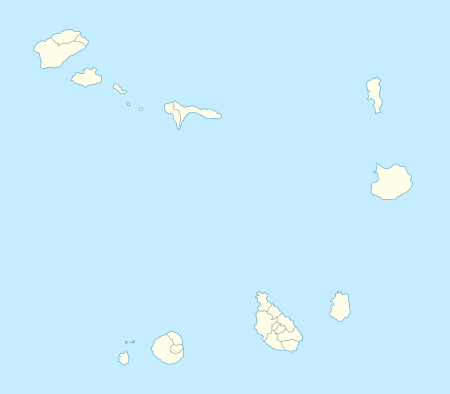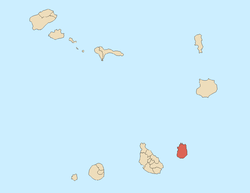Cidade do Maio
| Cidade do Maio | |
|---|---|
| Settlement | |
 Cidade do Maio | |
| Coordinates: 15°08′17″N 23°12′40″W / 15.138°N 23.211°WCoordinates: 15°08′17″N 23°12′40″W / 15.138°N 23.211°W | |
| Country | Cape Verde |
| Island | Maio |
| Municipality | Maio |
| Civil parish | Nossa Senhora da Luz |
| Population (2010)[1] | |
| • Total | 2,971 |
Cidade do Maio, also known as Porto Inglês, is a city in the southwestern part of the island of Maio in southeastern Cape Verde. It is the main urban settlement of the island, and also seat of the Maio Municipality. The population has doubled between 1990 and 2010. Between 1975 in 2015, before it became a city, it was known as Vila do Maio
The city is still (colloquially) known by its old name, Porto Inglês (Portuguese for "English port", the official name until 1975), in opposition of the older Porto Português (present day Calheta). the older name was that 17 English ships a year visited Maio to transport salt to England until the 19th century, England had a great influence on salt trade. Salt monopolies occurred in the 20th century which was done by António Évora. Salt is produced in small amounts today, it is exported to Guinea-Bissau.
The port of Vila do Maio (once known as the English Port) has ferry services to the island of Santiago with Praia and is based hundreds of meters from the center and 1 km north has an airport). The city's main street is named Amílcar Cabral. The surrounding area consists of a desert and grassy landscape unlike the middle and east of the island, vegetation is not dense, saltmarshes lie to the northwest which were used for salt mining. Tourism is now one of the dominant factor of the city, large sized apartment complex and hotels dominate the north next to its airport, a small industrial area lies to the eastern portion.
Famous landmarks include Forte de São José and its adjacent lighthouse, located in the east is Estàdio Municipal do Maio first opened in the early 2010s. A church first opened in 1872 and was financed by salt taxes.
The inconclusive Battle of Maio was fought between British and French frigate squadrons close to the town on 23 January 1814 in the last stages of the Napoleonic Wars.
Sports clubs includes Académico 83, Onze Unidos, Beira Mar and Real Marítimo, each has a football (soccer) club and some also has a basketball, volleyball and now futsal.
Historical population
| Year | Population |
|---|---|
| 1990 (June 23, Census) | 1,573 |
| 2000 (June 16, Census) | 2,673 |
| 2010 (Census) | 2,971 |
City twinning
References
- ↑ "2010 Census results". Instituto Nacional de Estatística Cabo Verde (in Portuguese). 17 March 2014.
